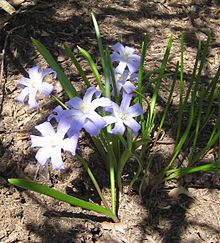- Chionodoxa luciliae
-
Chionodoxa luciliae Scientific classification 
Kingdom: Plantae clade: Angiosperms clade: Monocots Order: Asparagales Family: Asparagaceae Subfamily: Scilloideae Genus: Chionodoxa Species: C. luciliae Binomial name Chionodoxa luciliae
Boiss.Chionodoxa luciliae (syn. C. gigantea) or Lucile's Glory-of-the-snow is a bulbous perennial from west Turkey flowering in early spring. After flowering, it goes into dormancy until the next spring. The Latin name is in honour of Lucile, the wife of the Swiss botanist Pierre Edmond Boissier.[1]
Like all members of the genus Chionodoxa, the bases of the stamens are flattened and closely clustered in the middle of the flower. In the related genus Scilla, the stamens are not flattened or clustered together.[2] The differences are not considered by some botanists as sufficient to create a separate genus, so they include this species in Scilla.[3]
Each bulb produces two leaves, up to 8 cm long and 2 cm wide, and at most one flowering stem, up to 10 cm long. The flowers are produced in a loose pyramidal raceme, with 2-3 flowers per stem, which face upwards. Each flower is up to 3.5 cm across. The base of each tepal is white (as are the stamen filaments), producing a white 'eye'. The outer part of the tepals is violet-blue. The species can be distinguished from the commonest form grown in gardens, C. siehei, by the much smaller number of slightly larger flowers per stem.[4]
Notes and references
- ^ Paghat's garden
- ^ Mathew 1987, p. 25
- ^ Dashwood & Mathew 2005, p. 5
- ^ Dashwood & Mathew 2005, p. 7
Bibliography
- Dashwood, Melanie & Mathew, Brian (2005), Hyacinthaceae – little blue bulbs (RHS Plant Trials and Awards, Bulletin Number 11), Royal Horticultural Society, http://www.rhs.org.uk/RHSWebsite/files/04/04d1dd16-01be-4c31-9510-8a081dfa23b0.pdf, retrieved 3 April 2010
- Mathew, Brian (1987), The Smaller Bulbs, London: B T Batsford, ISBN 978-0-7134-4922-8
- Mathew, Brian (2005), "Hardy Hyacinthaceae, Part 2: Scilla, Chionodoxa, xChionoscilla", The Plantsman (New Series) 4 (2): 110–21

This Asparagales article is a stub. You can help Wikipedia by expanding it.

